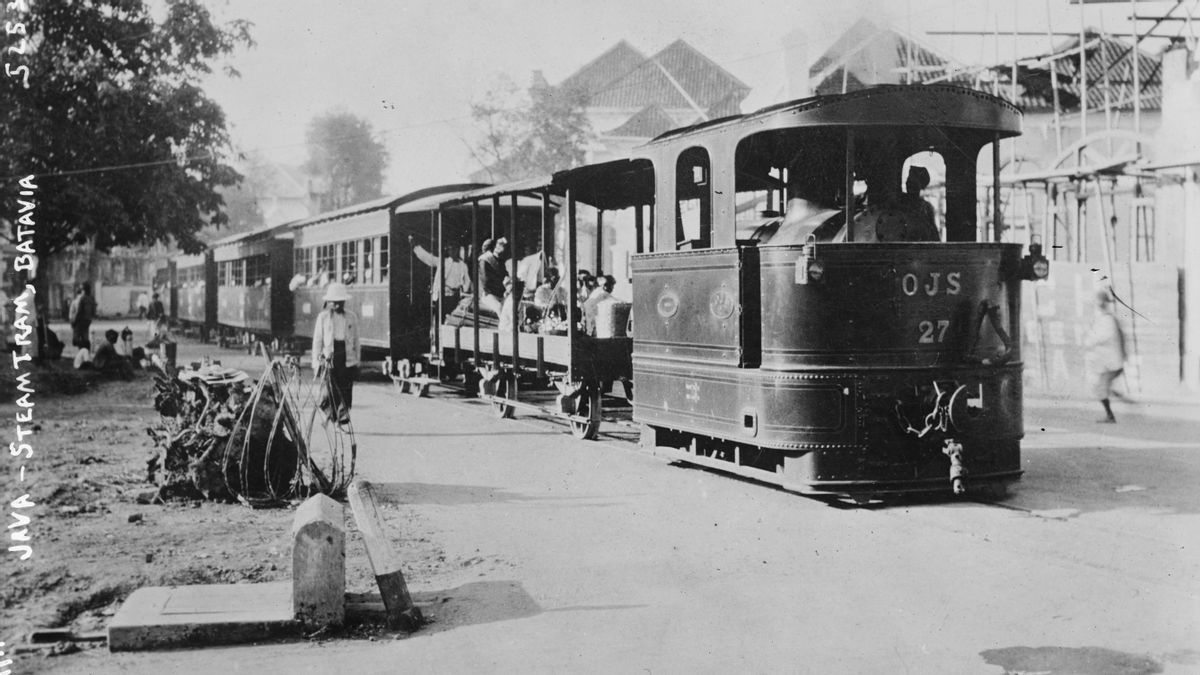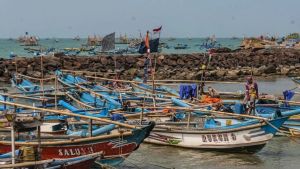JAKARTA - Twitter social media was enlivened with discussions about the discovery of the tram line from the Dutch colonial era. The rail construction was found under a concrete road in the Glodok area, Central Jakarta. The MRT project, accidentally found a number of historical artifacts.
This tram line was discovered last August, when PT MRT Jakarta carried out a soil test for the construction of the MRT phase 2, the HI-Kota roundabout route. PT MRT Jakarta Construction Director Silvia Halim said that his party was still investigating the findings with archaeologists.
Contacted by VOI, Friday, December 24, Silvia refused to explain in more detail the process of this investigation. He asked us to wait until Monday, December 27, when PT MRT Jakarta would explain to the public about the MRT phase 2 construction process, including the finding of this tram line.
In its investigation, PT MRT Jakarta continues to coordinate with the DKI Jakarta Culture Service and the Restoration Session Team (TSP). "Monday will be presented. One of them is about this," said Silvia.
Treasure findPreviously, PT MRT Jakarta also found a number of historical artifacts at the MRT Jakarta phase 2 project site. The historical objects are thought to date from the 18-20 century AD.
The artifacts range from bullets, pottery bottles, Chinese and European ceramic fragments to the teeth of bovidae, a kind of ruminant animal such as buffalo and bison.
All of them were found at 14 excavation points in the MRT phase 2A construction area, to be precise, from the underground area of Jalan MH Thamrin to parts of Jalan Medan Merdeka Barat.
Now the findings have been displayed in the visitor center, a gallery space built by MRT Jakarta.
History of trams in BataviaDuring the Dutch colonial period, the tram was a transportation system that connected access to human movement in Batavia. There were three types of trams in operation: horse trams, steam trams to electric trams. All of them leave interesting stories.
horse tram

Horse tram, for example. The horse tram in Batavia was based on the idea of an Indo-Dutch citizen, Mr. J Babut du Mares. As described in the daily Java Bode, published in December 1860, at that time Mares saw the limitations of mass transportation in the capital city. And the horse tram, is the solution in his eyes.
The idea of mares reached the ears of the colonial government. No kidding, they, the Company with high seriousness, realized the plan to procure a horse tram.
Dummler & Co. also known as Bataviasche Tramweg Maatshappij (BTM) was mandated to build and operate trams in Batavia. Quoted by Zeffry Alkatiri in Gambir Market, Chinese Comics & Shanghai Ice: The Melik Side of 1970s Jakarta (2010), apart from Mares, another Dutchman named Martinus Petrus who is also the founder of Dummler & Co. take part in the Batavia dream project.
Through his company, the horse tram was built on August 10, 1867. Petrus believed that the horse tram would become an effective, efficient, fast and cheap mass transportation.
The horses were imported from various regions in the archipelago, from Sumba, Tapanuli, Sumbawa, Priangan, to Makassar. The horses were used to tow the tram carriages on the rails which have a track width of 1,188 millimeters.
He explained, it took three horses to pull a train carriage with a capacity of 40 passengers. At that time, the route of the horse tram was held from Amsterdam Poort (Kota Diamond)–Binne Nieuwpoort Straat (Jalan Pintu Besar Utara)-Molenvliet (Jalan Gajah Mada-Hayam Wuruk) and ended at Harmoni.
Due to the high demand, the route was then developed -- two months after its inauguration -- from Harmoni to Tanah Abang, Harmoni-Rijswijk (Veteran Street)-Kramat, and ending at Meester Cornelis (Jatinegara). Instantly, the horse tram captured the hearts of the citizens of Batavia.
Because of its popularity, people who lived at that time always heard the sound of trumpets when horse trams came across the streets of Batavia. For them, the sound is not only a sign of the presence of a horse tram, but also a sign of progress.
Although so popular, the existence of horse trams also provoked a lot of problems. The biggest problem is cleanliness.
Horses can defecate and pee wherever they want. The streets were filled with dirt and its pungent smell.
In addition, the problem is exacerbated by the number of horse deaths. The daily Java Bode also highlighted this in a review in 1872. According to reports, as many as 545 horses died.
"One of the reasons is fatigue. In fact, there is a stipulation that these animals are only allowed to pull the tram no more than once per route,” said Alwi Shahab, one of the important figures in the writing of Jakarta's history.
steam tram

After the horse-powered tram in 1869, the residents of Batavia began to know about the steam-powered tram since 1882. Instantly, the steam tram received a warm welcome in Batavia. The steam tram is even considered the most modern means of public transportation as well as the deadliest of its time.
The presence of the steam tram is considered the successor to the existence of the horse tram which has many problems. The Dutch government and the firm Dummler & Co. brainstorm replacing horse trams with steam tramway engines or commonly known as steam trams.
The author of HJA Dufarc, in his book which discusses the history of trams in Batavia and Surabaya, Trams en Tramlijnen, De Elektrische Stadstrams op Java (1972), describes the early stages of the presence of steam trams. At that time the Company used the horse tram line. This continued until all facilities were gradually replaced and completed in 1884.
However, the steam tram in Batavia is not like the steam tram in other countries. While steam tram locomotives are usually filled with water and then heated with coal fire or wood fire to produce steam, the steam tram locomotive in Batavia consisted of a boiler called remise.
At its base in Kramat, remise is filled with steam that has had a certain pressure. Armed with this canned steam, the tram is strong enough to move on the "lijn" (trajectory) from Kramat to Kota (Oud Batavia), then to Meester Cornelis (Jatinegara) and back again to its base to refuel with the canned steam.
Every time the steam tram passed, the distinctive sound of its bells lingered in the memories of the citizens of Batavia. On top of the locomotive, the Bumiputra driver stood with officers ready to light a fire. Usually the driver is accompanied by two Bumiputra conductors who are in uniform, but barefoot. Meanwhile, the chief conductor is a European who is usually a retired soldier.
Although it was hailed by the citizens of Batavia, the presence of the steam tram in the end caused various problems, especially in the rainy season. That's none other than the innovation of canned steam is not a perfect invention.
As a result, when it rains, the steam tram often breaks down because the canned steam has cooled. It is the same in the dry season. The power of the steam power is sometimes insufficient to pull the carriages across the Kramat bridge -- the bridge that connects Kramat Bunder and Kwitang.
As a result, the citizens of Batavia often saw the steam tram unable to cross the bridge. However, the problem of the tram breaking down is not too big compared to the problem of accidents caused by the presence of the steam tram. The number of accidents caused by steam trams in Batavia is the highest. No kidding. The steam tram is dubbed the “biggest killer roaming Betawi City.”
"You see, one time he (steam tram) killed a victim every four hours. Betawi people like to joke around and use the initials NITM to make fun of them: Ride This Is Sure to Die," was written in an article entitled Naik Ini Definitely Mati in the book Ketoprak Jakarta (2001).
electric tram
Mass transportation technology in Batavia or Jakarta has developed rapidly since the late 19th century. After the horse-powered tram appeared in 1869, then evolved into a steam-powered tram in 1882, until successfully adopting the electric tram in April 1899.
The electric tram even existed in Batavia before in the Netherlands. It is noted that the land of the Windmills only adopted this mode of public transportation in July 1899, or more precisely three months after Batavia. This then became a byword throughout the city.
There is no responsibility for making it. In addition to the lijn (trajectory) which was built in almost all important areas of Batavia, the operating schedule is already busy, which is every 10 minutes.
Just like the previous trams, the passenger class on the electric tram is also different. First class with a ticket price of 15 cents are usually boarded by Europeans.
Then, the second class with a ticket price of 10 cents, usually contains passengers from foreign easterners, such as Chinese, Arab, and Indian. Finally, the third class is for the natives at a rate of 5 cents. One way, the tram is capable of towing three carriages.
As quoted by Mona Lohanda in her book History of the Authorities Who Managed Batavia (2007), initially the electric tram was managed by the Batavia Elektrische Tram Maastschappij (BETM) company. Then when Burgermeester (Mayor) Batavia, Ir. Voorneman realized the great potential of this company in 1925, he merged the company with the Nederlandsch-Indische Tramweg Maatchappij (NITM), until Bataviasch Verkeers Maatschappij (BVM) was born.
The electric tram route has expanded to six lines. First, the Fish Market-Kampung Melayu. Second, Fish Market-Gondangdia, Third, Fish Market-Gondangdia via Sawah Besar. Fourth, the Tanah Abang Fish Market. Fifth, Tanah Abang-Jakarta Kota. Sixth, Jakarta City-Five Bridge.
Thanks to the fame of the electric tram, the Dutch writer, Louis Couperus in his novel entitled De Stille Kracht (1900) published the case of the existence of the electric tram in Batavia. Couperus mentions Europeans who used electric trams at that time as a form of their miserliness in the Dutch colony.
“In the morning, as she shopped in the shops of Rijswijk and Molenvliet, which, some given French names, tried to give the southern shopping center a European luxury feel, Eva saw the exodus to the Old Town of white people. The exodus filled the tram with the white weight of death. Many, already rich, but not yet rich enough for their purposes, took the tram with their carriages to the Harmony Club, where they took the tram to save their horses,” Couperus relates.
The existence of electric trams in fact has a long life. After Indonesia's independence from Dutch colonial rule, the electric tram network still operates on some of Jakarta's main roads. The enthusiasm of the Indonesian people at that time was quite high for public transportation vehicles from the Dutch colonial era in the early 1950s.
Unfortunately, around 1959 the electric tram was discontinued. Investigate a calibaration, the termination was none other than the problem of lack of funds to maintain and rejuvenate it. Therefore, the owner of the policy decided to stop the operation of the electric tram. To the extent, the traces of the rail are barely left.
“The former tracks are now covered with asphalt, there are no traces of them anymore. During a roadside excavation in the Kota area for the Kota Tua rejuvenation project by the DKI Jakarta Government in 2006, several former electric tram tracks were found. The poles supporting the electric cables are no longer there. It's a shame that this electric tram was removed," wrote Firman Lubis in the book Jakarta 1950-1970 (2018).
*Read other information about HISTORY or read other interesting articles from Detha Arya Tifada, Diah Ayu Wardani, and Yudhistira Mahabharata.
Other BERNASThe English, Chinese, Japanese, Arabic, and French versions are automatically generated by the AI. So there may still be inaccuracies in translating, please always see Indonesian as our main language. (system supported by DigitalSiber.id)









